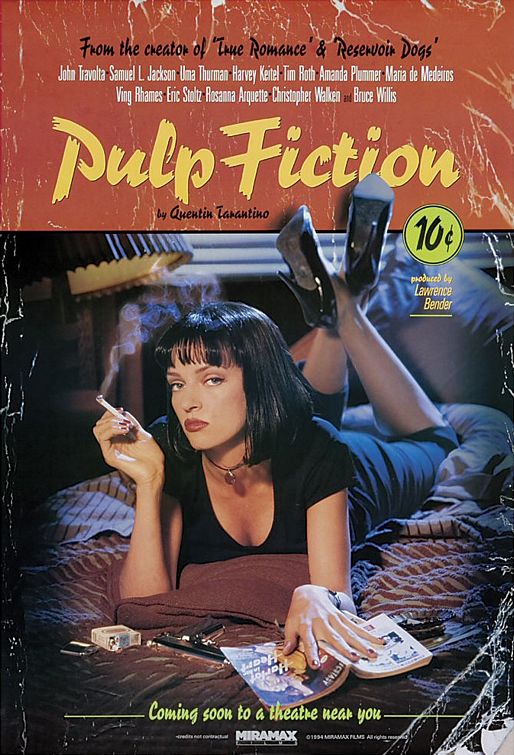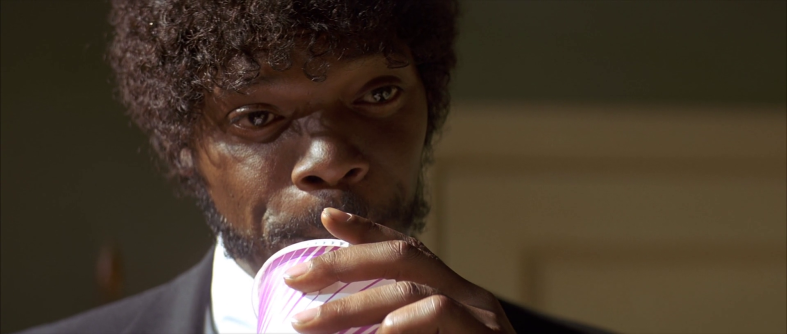Sometimes a single shot provides a huge emotional response. A well-placed shot can make the audience cry and reflect. It can sent shivers down your spine or make you re-evaluate your own life. The visual power of cinematography is not to be underestimated.
BUT. Sometimes, a shot does not touch you on some deep level of emotion. Sometimes a shot is just Awesome. And I’m not talking about explosions and Michael Bay-style showcases of effects, but about a real, honest awesomeness, a cool-factor, that makes it instantly memorable and classic.
These shots are so well thought out and implemented that just by seeing them you become giddy as a little child. Again I stress; I am not talking about shots that create that effect because of effects-work. Visual effects are a very important part of filmmaking and often tightly integrated with camerawork (especially before the digital era), but they are not, by themselves, cinematography. Or at least, their effect is not distilled from the cinematographic art, but rather from other disciplines like set-design, miniatures, CGI, etc.
No. I’m talking about shots that are awesome because of their cinematographic value and thought-out construction. They are shots that might, at first, pass you by without you noticing them. They can be almost invisible, but they linger. Boy do they linger….
All this build up must then lead to a pretty awesome One Shot this week, right? Well, what better way to make up on that promise than by pulling the One Shot from one of the coolest movies of the nineties; Pulp Fiction.
Pulp Fiction
Pulp Fiction (1994) is a classic. One of the big classics of modern cinema. Directed by Quintin Tarantino, Pulp Fiction was that zeitgeist-film that seemed to resonate with its present culture and audience like no other. Its non-linear, post-modern & humorous presentation of simple crime-stories was fresh, unique and original. Well, original in the sense that never before had a film so blatantly referenced pop culture and filled itself up with references, nods, homages and tributes. It was a style of storytelling that later found its way into other popular films like Scream (1996) and maybe even The Matrix (1998) -though the latter was less upfront and more serious about its homages-.
Now, almost 20 years later, the film still holds up through its storytelling (which still feels fresh and original today) and clever cinematographic tricks. Of course, the screenplay and acting got a lot, if not most of the recognition from the audience and critics. It was all about the dialogues and the comeback performance of John Travolta and powerhouse acting of Samuel L. Jackson (who, after Pulp Fiction, was destined to forevermore be nothing if not the-coolest-motherfucker-in-film). And those deserve their attention, no doubt. But there is also some very, very cool cinematography going on in the film.
Cinematographer Andrzej Sekuła, who is actually most famous for this film and Tarantino’s previous Reservoir Dogs (1992), played around a lot with unconventional framing and composition. Take, for example, the dialogue between Marcellus Wallace and Butch Coolidge early in the film. Sekuła chooses to frame it in a perfectly conventional over-the-shoulder shot, but he chooses to focus on the backside of Wallace’s head instead of the face of Butch. By doing that he forces us to focus on that bald head, with the mysterious bandaid, and wonder what the guy looks like. It’s such an effective way to suggest the mystery and danger surrounding Marcellus Wallace.
Or the surreal choice to film the entire dialogue scene between Butch and the cab-driver in such an obvious fake rear-projection setup, which gives the scene an incredibly cool stylistic atmosphere. Sekuła and Tarantino play with that sense of staged-reality several times during the movie (like the moment Mia Wallace draws a square in mid-air, or the magical glowing content of the briefcase) which further heightens it’s postmodern, pulpy style.
It’s a tricky thing to play with those techniques and not lose the character and emotion of the story. Stylizing shots creates distance between the story and the viewer and makes the film appear more as art, you become aware of its constructed reality. That’s often a problem with self-referencing and postmodern movies, you can lose your emotional connection to the story.
But Tarantino managed to underplay it just enough and Sekuła appeared to be fully into his game. Pulp Fiction survives on its characters and narrative.
One Shot
Then the question comes; which shot in Pulp Fiction is my favorite? It’s actually a little one, story wise, but it kept on resonating with me, for years and years. Here it is:
Yes, it’s Samuel L. Jackson sucking Sprite through a straw.
I’m a big fan of shots that are iconic, as I spoke about in previous posts here. To me, this is an iconic shot. Maybe not the most iconic shot, but it works in different ways.
It’s function in the film is two-ways. First of all it is there to build tension. The shot lasts for several seconds and is devoid of movement. It’s just Jules’ cold eyes staring off camera to Brad while he is drinking. As we all know there is a shootout coming, or at least people will get killed (it is a Tarantino movie of course), the time it takes to get to the first shot is equal to the tension that is rising.
Taking so much time to quietly drink a soft-drink is a great tension builder. You know Jules is mad and ready to kill, but Samuel L. Jackson plays it with such restraint that you expect the bomb go off any second.
And just look at the shot from a technical point-of-view. There is a light reflecting in Jules’ eyes, which I’m guessing is the wrapping from the burger, which gives him a sort of inverse pupil, making him seem less real, less a regular human, further heightening the tension. You just cannot read his eyes and guess his thoughts, and that partly comes through this little trick.
But then, and this is the second thing the shot does, it also reaches the level of humor. This is due to Jules frowning in a way that suggests a nonchalance (great performance there), as if he’s saying ‘I am going to kill you, but I’m drinking your sprite first…so what!’. And there’s humor in the absurdity of the act of sucking so intently through the straw in front of the guy you are threatening to kill.
That humor also comes from the framing. It’s not a truly close-up shot, but there is a slight wide-angle distortion of perspective which enlarges Jules’ features slightly. It’s not obvious or overdone, thus keeping the viewer fully in the scene.
So there you have it. My favorite shot from Pulp Fiction. It shows, to me, how magical cinematography can be, even in small things, and how, when used tastefully and with restrain, those slightly absurd ideas and techniques can heighten the cinematic effect on the viewer, without taking you out of the story.



Excellent review, love this film.
I’ve discovered this blog tonight and just had a fantastic archive binge – I love how you’re analysing your shots – insightful but without pretension. Keep up the good work!
Thanks man! I’ll definitely try to keep it up!
well sick
oh wait no your theory is wrong